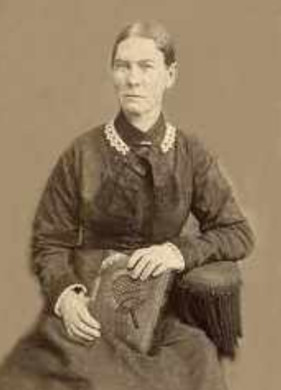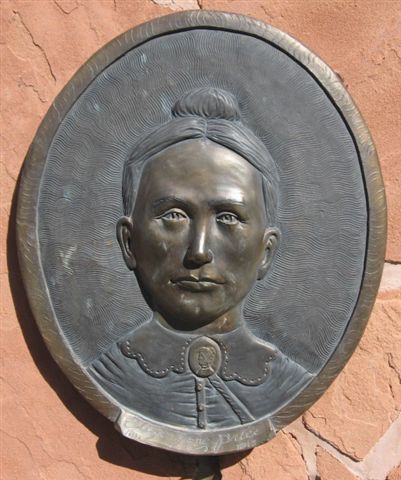Eliza Jane Adair
Eliza Jane Adair was a persevering pioneer woman who was born on 11 Nov 1811 [or 1810 as on her tombstone--JPP] in West Carthage, Tenn. She was one of eleven children, all of whom survived childhood, which was unusual in those days. The family moved several times in her youth, also living in South Carolina, where her older brother Samuel had been born, Indiana where her brother Thomas was born, and in Alabama where her youngest sisters were born, and where they apparently settled down. Her father ran a large cotton plantation.
She married Samuel Carson and had four children by him in Carrollton, Pickens County, Alabama. Her first child John Carson lived only a few months, but the others survived. Then her husband died on her baby William's first birthday, leaving her a widow for two years. She remarried to Moses Pearson and they had a daughter Margaret, also born in Pickens County. He was thrown from a mule and killed, again leaving her a widow with four children for six more years.
While in Pickins County and shortly before before her marriage to her third husband John Price, two Elders came (one source says one was Elder Ritchey) from Nauvoo preaching the restored gospel. She and John accepted the gospel along with her mother's family who were still at home. Eliza was the first of her siblings to be baptized into the church, along with her future husband John, on her birthday: Sat 11 Nov 1843. Most of the rest of her brothers and sisters followed within the next two months.
Soon afterward the people of this neighborhood became hostile and came in mobs and compelled the Saints to leave their homes [see details at mobs -- JPP]. Driven out, they then crossed on the east side of the river, where there was a small branch of the Mormon Church.
After their marriage on 3 Dec 1843 in Itawamba, Mississippi, John and Eliza Jane Adair Price began their family in Mississippi where they apparently lived for two years. They then moved two miles west on the Rigby River [I cannot locate this.-JPP]. According to my records, John and Eliza's first child, Becky Ann, was born in Pickens County, Alabama, in 1845 so apparently they had returned there.
In the fall of 1845, they started to move from that county about the first of November. They arrived in Nauvoo on the 6th of March, 1846. They joined the other saints and started their trek to Utah. Her mother Rebecca Brown Adair also came with them.
Eliza gave birth to George in van Buren county Iowa in 1847, but her son William Carson died that year at age 12. They suffered greatly at Mount Pisgah, Iowa where her mother died and her brother Thomas Adair lost his wife Fanny and two of his four children. Many of their relatives died there, but Eliza's son Valentine Carson later married Thomas's surviving daughter, Mary Ann Adair. John and Eliza's third child John was born there in 1849 but he only lived 8 months and died in December of that year.
 |
Eliza Jane Adair Price.
TFinally the opportunity to join the saints in Utah came, and they crossed the plains in 1851. Hyrum was born to them in Iowa just as they began the trip in April. In Salt Lake City, she and John had their marriage sealed for eternity in 1852, and on 2 Jul 1853 Joseph (Jode) was born to them there. But the adventure of crossing the plains was only the beginning of their pioneering efforts. At the October conference of the church in 1856, Brigham Young called ten families from the Southern States to found a community at a place he named Washington to grow cotton in southern Utah. This would be the first "Cotton Mission." Jacob Hamblin had shown earlier that year that cotton could be raised there. During the preparation for the move, Eliza gave birth to her last daughter, Eliza Jane Price in January, 1857.
The ten families called included John and Eliza's and also the families of all of her living siblings: Samuel, Thomas, George, and John Adair, and her sister Mary Ann Mangum and her husband John Mangum. Samuel Adair headed the group which left on March 3, 1857 and arrived the following April 15. Thus, six of the original ten families were those of the Adair siblings. Their father had run a large cotton plantation, so they were well prepared to head the Cotton Mission.
Twenty-eight more families were called in April to join them that summer. Soon her son Valentine Carson and his wife Mary Ann Adair Carson, who was her niece, also joined them. They called the area "Dixie", which name still refers to all of that area of Southern Utah, including St. George which was founded four years later.
Eliza Jane was a mid-wife and family doctor for many years to the people of Southern Utah and the Dixie country. She blessed many homes helping to bring many a bundle of joy into the homes, many babies were born with her as mid-wife and nurse. Grandma traveled in many distant parts alone with her team and buggy. She had eleven children, in all, of her own and loved all children. She would go to Nevada as far as Pioche and nurse the sick and bring their babies into the world. She did so many kind deeds for the poor when they were in trouble and needed help. She never expected much pay, never did she take anything from the really poor families. She brought about three hundred babies into this world.
Many serious problems plagued the new community. Many of them contracted malaria from the mosquitoes there, but the cause was then unknown. They also got typhoid and dysentery from bad water. The ground was very alkaline which made it hard to grow cotton. Several families left after the discouraging first season. Three years lated, Eliza's daughter Eliza died before reaching her fourth birthday. Another very discouraging factor was their inability to tame the Virgin River for irrigation, which defied all attempts. It broke their dams seven times in their first three years there. In late 1861 when the group who were going to settle St. George passed through, Robert Gardner wrote that seeing the Washington saints "tried me more than anything I have seen in my Mormon experience. Thinking that my wives and children, from the nature of the climate, would have to look as sickly as those now around me..." He noted how they were as blue as the homemade, weed-dyed cotton clothes they wore, and were all shaking with Malaria.
Even as late as 1889, the dam gave way. Many inhabitants left at that time and the population dropped from about 600 to only 300. But Eliza lived to see a new dam completed in 1891 which finally succeeded. Cotton was no longer grown much after the arrival of the railroad, which brought inexpensive cotton from the South, but Washington City has continued to grow from that time, and is now thriving at 7,000, the legacy of these indefatigable families. Eliza died in Washington, Utah, on 16 Aug 1892 at the age of 80, having been faithful to the mission where she was called.

